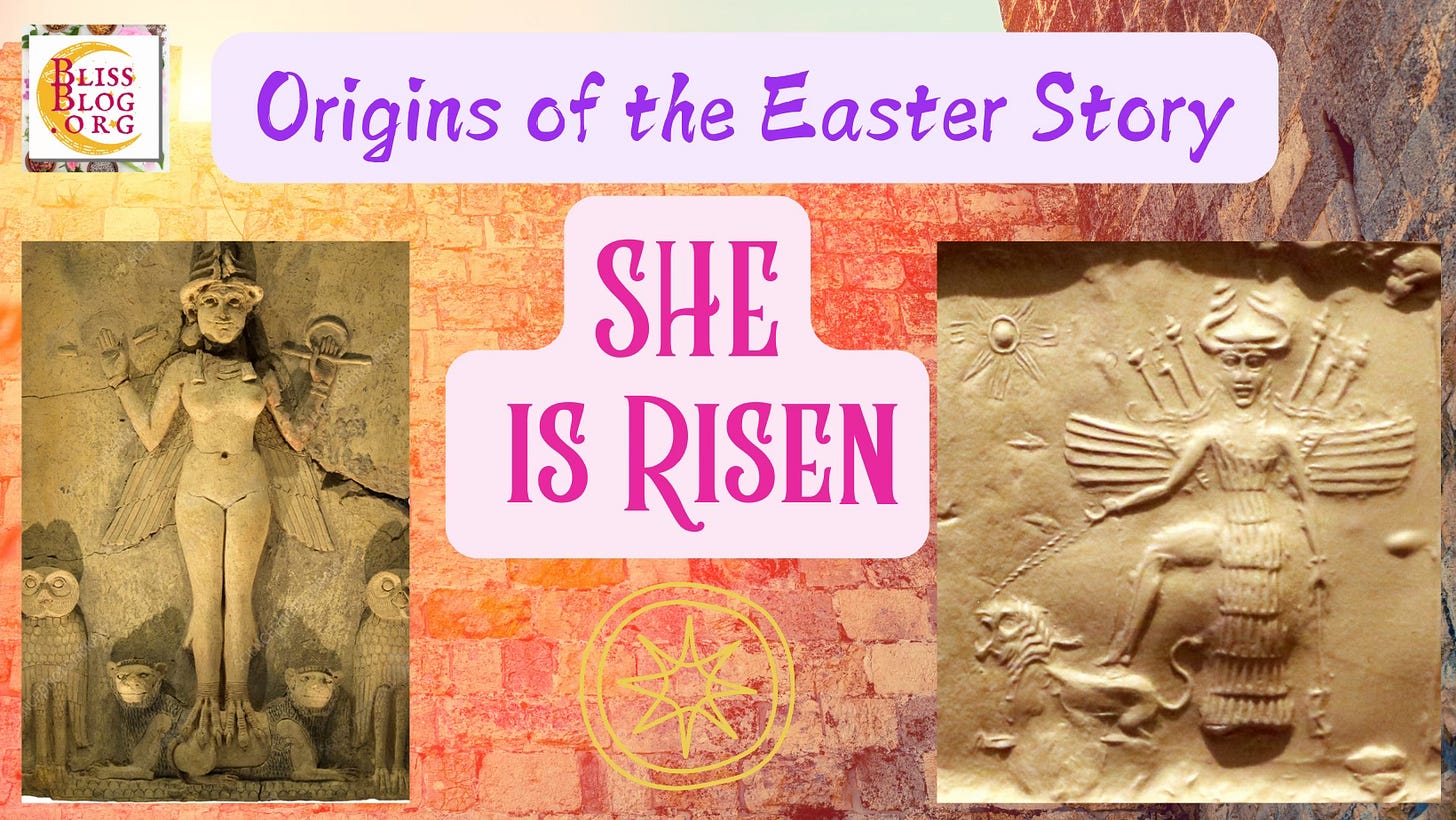Obligatory disclaimer: This piece is designed to show commonality, rather than difference. When the same basic story is told over and over again throughout millennia, with only the details shifting to reflect the norms of each successive culture, that tells us there is deep value and truth in the tale. This piece does not seek to discredit Easter, and in fact validates it as a tale that has been told throughout the ages, much like the biblical flood story.
Inanna
The images above are of the Goddess Inanna of ancient Sumer, daughter of the moon god Nanna, sister to the sun god Utu and the Underworld Goddess Ereshkigal. She started her career as a lesser goddess, and rose to “Queen of Heaven,” largely due to the efforts of one of her priestesses, Enheduanna, who was a writer.
Enheduanna’s stories about Inanna were the first stories with the author’s name attached. They spread throughout ancient Sumer, and were copied to practice writing at the edubba schools. And so we had the first bestselling author.
Some scholars suggest only males were allowed to learn to write the sacred script. But that’s obviously untrue in the case of the high priestess Enheduanna.
By the way, a collection of Enheduanna’s translated writings is available under the title: The Harps that Once Sang, Sumerian Poetry in Translation by Thorkild Jacobson, and in Inanna Lady of Largest Heart, Poems of the Sumerian High Priestess Enheduanna by Betty de Shong Meador.
There are many tales of Inanna, but the one that applies here is the one where she “set her eye upon the underworld.” She wanted to go there, to conquer its mysteries one version says, but she knew she risked permanent death. No one returns from the underworld! So she left instructions for her most trusted advisor, the goddess Ninshubar, on how to get her out, in case she didn’t return.
Inanna spent 3 days in the Underworld, where her sister Ereshkigal was queen. She was stripped of all her possessions, all her garments one by one as she passed through each of the seven gates on the way, and upon arrival, she was struck dead and hung on a wall.
After three days, Ninshubar began executing the plan to get her out, going from one god to the next asking their assistance until eventually one agreed. She was given the “bread of life” and the “water of life” and she revived, and returned, but there was a catch.
She could leave, but she must send a substitute to take her place. Two underworld goons accompanied her to see to it she didn’t renege.
And so Inanna journeyed in search of a replacement, but no one seemed deserving of death, until she returned to her palace to find her husband, Dumuzi, (Dumuzid, Tammuz) apparently partying hardy in her absence. He wasn’t mourning her or missing her or doing anything to rescue her. And so he took her place, and off he went. (In later versions the goon squad took him and Inanna had no say.)
Eventually, again in later tales, Dumuzi was permitted to return to the land of the living for half of every year, while his sister Geshitanna took his place, thus explaining the changing of the seasons.
Echoes of this tale linger in the much later Greek stories of Persephone and Hades, also used to explain the changing seasons.
Inanna became Ishtar became Astarte became Aphrodite became Venus.
Different names, same message
The core of the tale is the same in all cases. It is the tale that proves the inevitable triumph of life over apparent death. It’s how people made sense of cycles of nature. Here, where I live, those cycles are the apparent death of winter, and rebirth of spring. In ancient Sumer, they likely reflected the flood cycles of the twin rivers, which brought lush fertility at the beginning of each growing season, and waned toward the time of harvest leading to a period of deathlike repose between growing seasons.
The message is that even when all seems lost, even when apparent death is all we see, life is lurking just beyond the veil, waiting for the proper time to re-emerge, which always comes, right on schedule.
We can trust in that pattern, that cycle. Life will always return and renew.
As without, so within
Whatever is happening in nature is also happening within us. Mentally we get fresh ideas and inspiration. Physically we feel our energy rising with the longer days and shorter nights. Our spirits are fed with every flower blossom and baby animal we glimpse.
Life abounds. Death is an illusion, and a temporary one at that.
That’s the joyous, uplifting message of Easter, whether you place Jesus or Inanna into the main role.
Life wins.
And so this is springtime, a time for hope, for renewal, for growth, for expansion, for fertility, for planting, for tending all that is good.
It’s a time, too, for tilling last year’s rot into the soil where it can do some good.
Let the old crap go. Embrace the new growth.
Sound up!
Got Witches?





